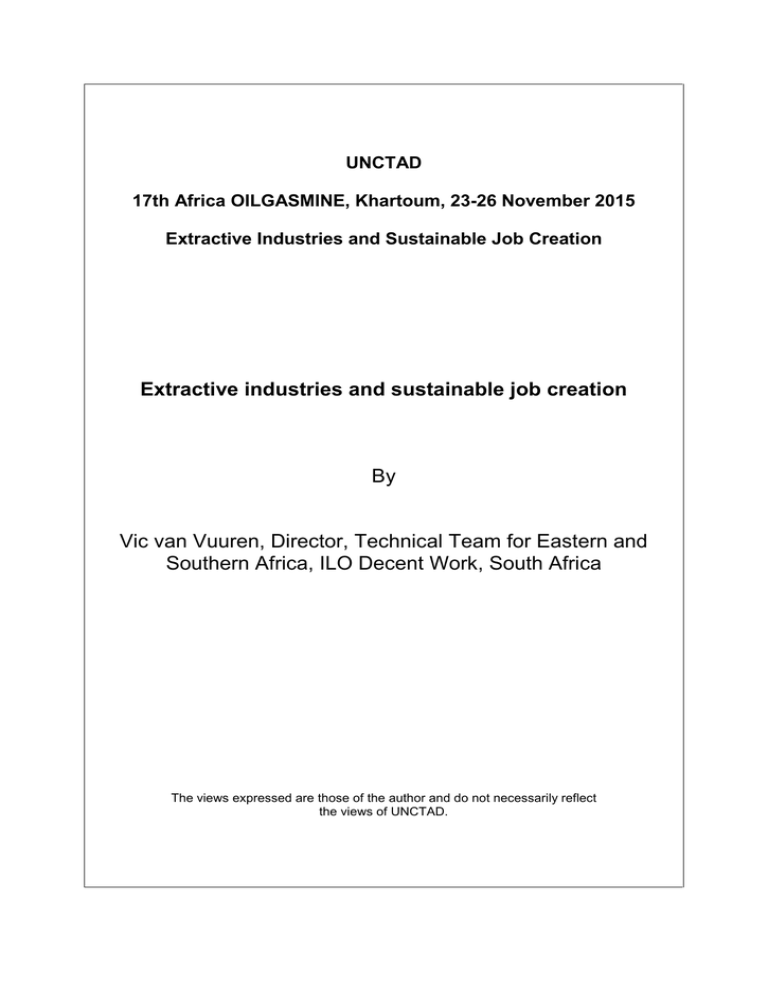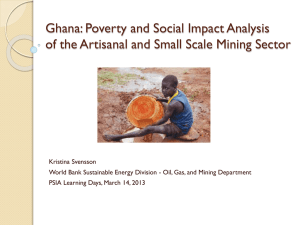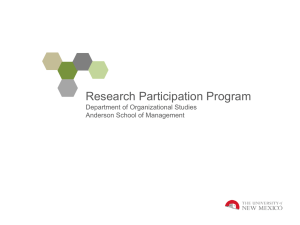UNCTAD 17th Africa OILGASMINE, Khartoum, 23-26 November 2015
advertisement

UNCTAD 17th Africa OILGASMINE, Khartoum, 23-26 November 2015 Extractive Industries and Sustainable Job Creation Extractive industries and sustainable job creation By Vic van Vuuren, Director, Technical Team for Eastern and Southern Africa, ILO Decent Work, South Africa The views expressed are those of the author and do not necessarily reflect the views of UNCTAD. OILMINEGAS Vic van Vuuren 24 November 2015 ILO • Started 1919 -Treaty of Versailles • Brought together the actors of the world of work • Pursuit of social justice • Advancing opportunities for women and men to obtain decent and productive work ILO • Four pillars of the Decent Work Agenda • employment creation • social protection • rights at work • social dialogue • SDG Goals • No 8 = Decent work ILO • Unemployment • 250 million unemployed • 61 m jobs lost since 2008 • Add 3 m in 2015 • Add 8 m in the next 4 years • SA 25,5% unemployment • Youth Unemployment • World Bank = 500m unemployed, underemployed or working in jobs with no security Extractive Industries • Processes of change are taking place at such a high speed and on such a scale as to constitute a transformation of the world of work. • ILO looking at the future of work • Modernisation of extractive industries which in the minds of most means mechanisation and the subsequent loss of jobs. • Need to look also at the modernisation of human resources content and processes Extractive Industries • The goal for employment creation should not just be quantitative, but also qualitative • Challenges include inter alia social dialogue and OSH • Extractive industries are capital intensive. • Extractive Industries are global and rely on highly mobile labour force which moves in line with the lifecycle of projects which dampens high local employment expectations Extractive Industries • An abundance of natural resources does not necessarily improve a country’s human development • Natural resource-rich countries in Africa tend to have lower average life expectancy and higher maternal mortality and under-five mortality rates than non-natural resource-rich countries with equivalent incomes. • Three types of employment • Direct Employment • Indirect Employment • Induced Employment Extractive Industries • Direct employment in mining is low, but mining projects can • • • • provide possibilities for infrastructure creation and mine sites can provide possibilities for jobs in servicing the mine and its workers (including transportation, repairs, accommodation, or catering). Recognize that mining is an industry with many hazards and in particularly we need to recognise the dangers of child labour. In many parts of the world, informal, small-scale mining is also often carried out in proximity to formal mining companies Small-scale mining is often carried out by untrained miners with no or little support given to improve working conditions and to guarantee rights Mining industry development should be integrated into rural development plans. Extractive Industries • ILO can assist in the following areas: • Decent Work Sector Programmes; • Central international standard: Safety and Health in Mines Convention, 1995 (No.176) and Recommendation No.183; • But also: Codes of practice on large-scale mining (such as Safety and Health in Underground Coalmines or Safety and Health in Opencast Mining (undergoing a revision); • Practical guidance for small-scale mining (handbook on safety and health in opencast small-scale mines); • Technical assistance in relation to child labour, social dialogue etc. Artisanal and Small Scale Mining • It is an area of priority in the Africa Mining Vision of the African • • • • Union (2009) ASM includes 20-30 million people worldwide with 3 to 5 times that number is indirectly supported through their activities ASM has been neglected by development partners, governments, wide industry players and NGOs-yet it can be a resilient livelihood choice for people who are vulnerable or looking for economic diversity in their livelihoods. ASM generates up to 5 times the income of other rural poverty driven activities in agriculture and forestry and employs 10 times more people than does the large Scale Mining sector and stimulates considerable local economic development. The diversity of sector players (including women, children, migrants and the most vulnerable means considerable diversity in the drivers and incentives for ASM activity. ASM – Structural Challenges • Weak laws, policies and implementation and government • • • • • • • • • marginalisation or repression. Cultural marginalisation and exclusion of certain demographic groups. Uncontrolled migration. Low barriers to entry into formal or illegal ASM with its poor social and environmental protections. Poverty driven. Poor access to financial services, market information, technology, and geological data. Political exclusion and “policy blindness”. Serious lack of data on ASM individuals and communities. Marginalisation and informality means very little knowledge from ASM communities reaches and influences policy makers. Use of Child labour is a CONCERN ASM – Social Problems • Women are often involved in processing and waste disposal, exposing them to harmful chemicals with sever consequences for family well-being and health, including during pregnancy. • ASM is one of the worst forms of Child Labour because of widespread and sever hazards that risk death, injury and disease. • Conflict between ASM and LSM activities are increasing as ASM increase and as LSM targets more remote areas LSM can damage ASM communities by causing inmigration, inflation, increased pressure on social services, dilution of culture and traditional beliefs and by undermining social cohesion. • Occupational and community health and safety tend to be very poor in ASM. ASM -Environmental Problems and Challenges • ASM for gold is the world’s second worst mercury polluter, responsible for one-quarter to one-third of global mercury pollution • ASM cause erosion; deforestation of protected areas; loss of diversity and water pollution etc ASM - Economic Challenges • Illicit activities, smuggling and exploitation in the trade of minerals is common place in many ASM activities. • Artisanal and small-scale mining receive as little as 70 per cent of the internationally agreed price of gold. • Income is often squandered and debt financing is common. Quo Vadis:The following points are important in defining future sustainable employment in the extractive industries. • Enabling environment • Regional integration • Monitoring and evaluation • Implementation • Social dialogue • Productivity • Education and reskilling • Beneficiation • Look at the value chain. THANK YOU






